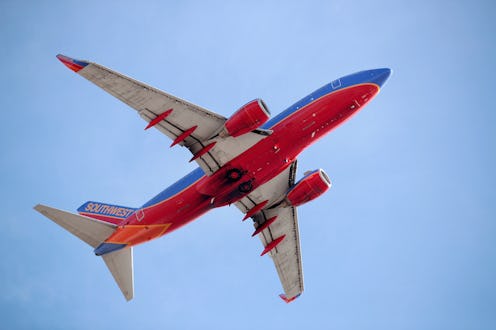Life
Flying May Get More Comfortable Soon

I have an idea: let's try free-associating with those enormous carrier planes that schlep people from far-apart destinations, like Sydney to Vancouver or New York City to Taipei. What comes to mind are probably images like these: rows upon rows of cramped, uncomfortable seats; awkwardly poking your sleeping neighbor so you can clamber over him to the bathroom; having the flight delayed by hours so the plane can be properly refueled and checked. Although strangers falling asleep on your shoulder and drooling down your shirt may be unavoidable, the new Double Bubble passenger airplane model can at least bring some welcome changes. Designed by NASA and MIT, it's wider and far more fuel-efficient than the Boeing 737 model.
The Double Bubble project took flight (OK, I'm sorry, you have to allow me at least one plane-related pun here) due to the incredibly high cost of airplane fuel. According to Gizmodo, fuel will cost airlines an extra $40 billion this year alone. But the issue isn't one that affects the economic world alone — a flight from New York to San Francisco releases two to three tons of carbon dioxide into the atmosphere per person. By creating a design that runs on just 30 percent of the fuel a 737 needs, NASA and MIT could be saving the ozone layer (and us) a lot of grief. Working models will hopefully be available by 2035.
But most of these innovations aren't due to radical leaps forward in aviation technology itself. Gizmodo writes,
"Of the whole 70-percent fuel savings, an astonishing 49 percent of it was derived solely from design changes, not the application of new airframe and engine materials."
Pretty nifty, right?
What's more evidently exciting for the average passenger is that the Double Bubbles will be roomier due to an extra five feet in cabin width. That may not sound like much, but when you're talking about the sardines-in-a-can approach that most planes use, it could make the difference between a majorly uncomfortable flight and...well, a minorly uncomfortable one. Although the Double Bubble flights will be a little slower than the average 737, their other features could save long-distance commuters a lot of trouble. Maybe they can even implement cockpit windshields that don't allow dumbasses with laser pointers to disrupt entire flights.
Although I will admit that I am slightly disappointed that a NASA/MIT-designed plane does not have a blow-up doll that can pilot it, à la Airplane!. But I will put my faith in the powers of science and trust that this, too, shall come to pass.
Images: Popular Science